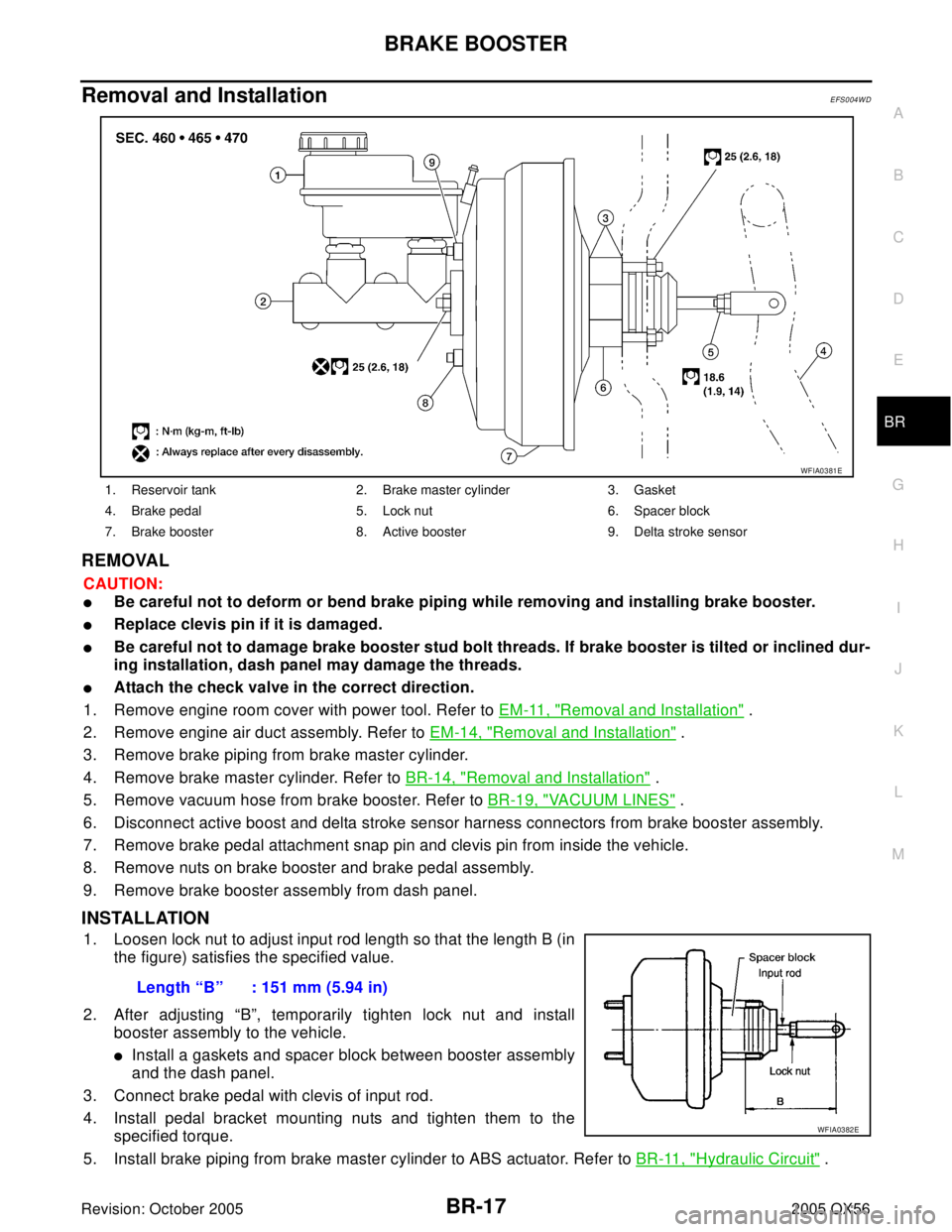Page 942 of 3419
BODY REPAIR
BL-175
C
D
E
F
G
H
J
K
L
MA
B
BL
Revision: October 20052005 QX56
ENGINE COMPARTMENT
MEASUREMENT
WIIA0551E
Page 985 of 3419
BR-6
BRAKE PEDAL
Revision: October 20052005 QX56
BRAKE PEDALPFP:46501
Inspection and Adjustment EFS004W0
INSPECTION
1. Inspect the brake pedal free height "H" from dash lower.
2. Adjust the height referring to the following specifications.
CAUTION:
The adjustable pedal must be in the forwardmost (closest to
the floor) position for pedal height measurement.
Brake Pedal Specifications
Unit: mm (in)
ADJUSTMENT
1. Loosen the stop lamp switch and ASCD switch by turning 45° counterclockwise.
WFIA0160E
Free height "H" : 182.3 - 192.3 (7.18 - 7.57)
Depressed pedal height "D" [under a force of 490 N (50 kg, 110 lb) with engine
running]: More than 90.3 (3.55)
Clearance between pedal stopper and threaded end of stop lamp switch and
ASCD switch "C
1 or C2 ": 0.74 - 1.96 mm (0.029 - 0.077 in)
Pedal play "A" : 3 - 11 mm (0.12 - 0.43 in)
Page 986 of 3419
BRAKE PEDAL
BR-7
C
D
E
G
H
I
J
K
L
MA
B
BR
Revision: October 20052005 QX56
2. Loosen lock nut on the input rod, then turn input rod to adjust the
pedal to specified height. When finished adjusting, tighten lock
nut.
CAUTION:
Make sure that the screw portion of the end of input rod is
located inside the clevis.
3. With the pedal pulled up and held by hand, press the stop lamp
switch and the ASCD switch in until threaded ends contact pedal
arm.
4. With the threaded ends of the stop lamp switch and ASCD
switch contacting the pedal arm, turn the switches 45° clockwise
to lock in place.
CAUTION:
Make sure that the gap (C) between the rubber stops and
switch ends are within specification.
5. Check the pedal play.
CAUTION:
Make sure that the stop lamp goes off when the pedal is
released.
6. Start the engine and check the height of the brake pedal when
depressing it.
Removal and Installation EFS004W1
Lock nut : 18.5 N·m (1.9 kg-m, 14 ft-lb)
PFIA0436E
WFIA0232E
Page 992 of 3419
BRAKE PIPING AND HOSE
BR-13
C
D
E
G
H
I
J
K
L
MA
B
BR
Revision: October 20052005 QX56
Inspection After InstallationEFS004W8
CAUTION:
If a leak is detected at the connections, retighten it or, if necessary, replace the damaged part.
1. Check brake tubes and hose connections for fluid leaks, damage, twist, deformation, contact with other
parts, and loose connections. Replace any damage parts.
2. While depressing brake pedal under a force of 785 N (80 kg, 177 lb) with engine running for approximately
5 seconds, check for fluid leakage from each part.
Page 995 of 3419
BR-16
BRAKE BOOSTER
Revision: October 20052005 QX56
BRAKE BOOSTERPFP:47200
On-Vehicle ServiceEF S0 04 WC
OPERATING CHECK
With engine stopped, change the vacuum to the atmospheric pres-
sure by depressing brake pedal several times. Then with brake
pedal fully depressed, start engine and when the vacuum pressure
reaches the standard, make sure the clearance between brake pedal
and floor panel decreases.
CAUTION:
Depressing pedal interval is approximately 5 seconds.
AIRTIGHT CHECK
�Run engine at idle for approximately 1 minute, and stop it after
applying vacuum to booster. Depress brake pedal normally to
change the vacuum to the atmospheric pressure. Make sure dis-
tance between brake pedal and floor panel gradually increases.
�Depress brake pedal while engine is running and stop engine
with pedal depressed. The pedal stroke should not change after
holding pedal down for 30 seconds.
CAUTION:
Depressing pedal interval is approximately 5 seconds.
BRA0037D
SBR3 65 AA
Page 996 of 3419

BRAKE BOOSTER
BR-17
C
D
E
G
H
I
J
K
L
MA
B
BR
Revision: October 20052005 QX56
Removal and InstallationEFS004WD
REMOVAL
CAUTION:
�Be careful not to deform or bend brake piping while removing and installing brake booster.
�Replace clevis pin if it is damaged.
�Be careful not to damage brake booster stud bolt threads. If brake booster is tilted or inclined dur-
ing installation, dash panel may damage the threads.
�Attach the check valve in the correct direction.
1. Remove engine room cover with power tool. Refer to EM-11, "
Removal and Installation" .
2. Remove engine air duct assembly. Refer to EM-14, "
Removal and Installation" .
3. Remove brake piping from brake master cylinder.
4. Remove brake master cylinder. Refer to BR-14, "
Removal and Installation" .
5. Remove vacuum hose from brake booster. Refer to BR-19, "
VACUUM LINES" .
6. Disconnect active boost and delta stroke sensor harness connectors from brake booster assembly.
7. Remove brake pedal attachment snap pin and clevis pin from inside the vehicle.
8. Remove nuts on brake booster and brake pedal assembly.
9. Remove brake booster assembly from dash panel.
INSTALLATION
1. Loosen lock nut to adjust input rod length so that the length B (in
the figure) satisfies the specified value.
2. After adjusting “B”, temporarily tighten lock nut and install
booster assembly to the vehicle.
�Install a gaskets and spacer block between booster assembly
and the dash panel.
3. Connect brake pedal with clevis of input rod.
4. Install pedal bracket mounting nuts and tighten them to the
specified torque.
5. Install brake piping from brake master cylinder to ABS actuator. Refer to BR-11, "
Hydraulic Circuit" .
1. Reservoir tank 2. Brake master cylinder 3. Gasket
4. Brake pedal 5. Lock nut 6. Spacer block
7. Brake booster 8. Active booster 9. Delta stroke sensor
WFIA0381E
Length “B” : 151 mm (5.94 in)
WFIA0382E
Page 997 of 3419
BR-18
BRAKE BOOSTER
Revision: October 20052005 QX56
6. Connect active boost and delta stroke sensor harness connectors to brake booster assembly.
7. Connect vacuum hose to brake booster.
8. Install master cylinder to booster assembly. Refer to BR-17, "
Removal and Installation" .
9. Adjust the height and play of brake pedal.
10. Tighten lock nut of input rod to the specified torque.
11. Install engine air duct assembly. Refer to EM-14, "
Removal and Installation" .
12. Install engine room cover with power tool. Refer to EM-11, "
Removal and Installation" .
13. Refill with new brake fluid and bleed air. Refer to BR-10, "
Bleeding Brake System" .
Page 1010 of 3419

SERVICE DATA AND SPECIFICATIONS (SDS)
BR-31
C
D
E
G
H
I
J
K
L
MA
B
BR
Revision: October 20052005 QX56
SERVICE DATA AND SPECIFICATIONS (SDS)PFP:00030
General SpecificationsEF S0 04 WQ
Unit: mm (in)
Brake PedalEFS004WR
Brake BoosterEFS004WS
Check ValveEFS004WT
Front Disc BrakeEFS004WU
Front brake Brake model CLZ31VC
Rotor outer diameter × thickness 320 × 26 (12.60 × 1.02)
Pad Length × width × th i c k n e s s 111 . 0 × 73.5 × 9.5 (4.73 × 2.894 × 0.374)
Cylinder bore diameter 51 (2.01)
Rear brake Brake model AD14VE
Rotor outer diameter × thickness 320 × 14 (12.60 × 0.55)
Pad Length × width × thickness 83.0 × 33.0 × 8.5 (3.268 × 1.299 × 0.335)
Cylinder bore diameter 48 (1.89)
Control valve Valve model Electric brake force distribution
Brake booster Booster model C215T
Diaphragm diameter 215 (8.46)
Recommended brake fluid Genuine NISSAN Super Heavy Duty Brake Fluid or equivalent
Brake pedal height (from dash lower panel top surface) 182.3 − 192.3 mm (7.18 − 7.57 in)
Depressed pedal height [under a force of 490 N (50 kg, 110 lb)
with engine running]More than 90.3 mm (3.55 in)
Clearance between stopper rubber and the threaded end of stop
lamp switch 0.74 − 1.96 mm (0.029 − 0.077 in)
Pedal play3 − 11 mm (0.12 − 0.43 in)
Output rod installation standard dimension 15.6 − 15.9 mm (0.614 − 0.626 in)
Vacuum leakage
[at vacuum of – 66.7 kPa(– 500 mmHg, – 19.69 inHg)]Within 1.3 kPa (10 mmHg, 0.39 inHg) of vacuum for 15 seconds
Brake modelCLZ31VC
Brake padStandard thickness (new) 11.88 mm (0.468 in)
Repair limit thickness 1.0 mm (0.039 in)
Disc rotorStandard thickness (new) 26.0 mm (1.024 in)
Repair limit thickness 24.5 mm (0.965 in)
Maximum uneven wear (measured at 8 positions) 0.015mm (0.0006 in)
Runout limit (with it attached to the vehicle) 0.04 mm (0.0016 in)